 Are you looking for creative ways to grow your social media following?
Are you looking for creative ways to grow your social media following?
Are you dealing with limited resources?
Then you'll want to study what Microsoft Dynamics did.
How is a giant like Microsoft the same as everybody else when it comes to social media marketing?
They have the same challenges as any company. They have to figure out:
- Whom they're talking to
- What their needs are
- Where and how to talk to them
And even though they're Microsoft, they still have limited resources to do it all. So how does Microsoft do social media? They start by trial and error, and then see what works and what needs changing. Sound familiar?
Over the past two years, Microsoft Dynamics, a business group of Microsoft, pruned their social channels by half, but now reaches more customers.
I spoke with Kelly Rigotti, senior marketing communication manager of social media for Microsoft Dynamics, to learn how they did it.
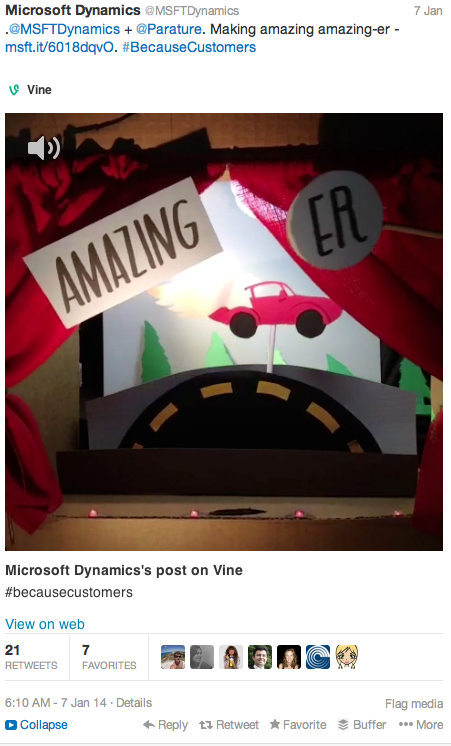
- Website
- Blog
- LinkedIn showcase page – 1,488,797 followers
- Twitter primary account – 13,813 followers
- Facebook primary account – 31,013 followers
- YouTube – 6,319 subscribers; 904,542 views
Highlights
- In 2011, had over 40 social accounts and blogs. Now has 23 accounts and blogs
- Up to 75% of followers of their LinkedIn showcase page see their updates
- YouTube views per month increased 700% over the last 15 months
- Facebook fans increased 900% over 15 months with 99% unsponsored posts
- Twitter account started from scratch in 2012 grown to over 13,000 followers
#1: Who's in Charge of Social?
Before Rigotti was hired two years ago at Microsoft Dynamics, they had over 40 social media accounts and blogs spread over multiple platforms. A lot of people had social media as part of their job. But no single person was responsible for it as a whole.
Rigotti sees the way things evolved at Microsoft Dynamics as similar to what happens at many companies.
“Nobody would dream of going off and doing his or her own website,” she said. “You don't go off and do your own advertising campaign.” But teams would start their own social channels because it was so easy.
Get World-Class Marketing Training — All Year Long!
Are you facing doubt, uncertainty, or overwhelm? The Social Media Marketing Society can help.
Each month, you’ll receive training from trusted marketing experts, covering everything from AI to organic social marketing. When you join, you’ll also get immediate access to:
- A library of 100+ marketing trainings
- A community of like-minded marketers
- Monthly online community meetups
- Relevant news and trends updates
“Somebody would hear about something new, like a blog, and get the okay from their manager to start it,” she said.
But the company realized they needed to start thinking strategically about social media. They created a new position and hired Rigotti, who had consulted for them previously. Her sole responsibility would be to manage social media.
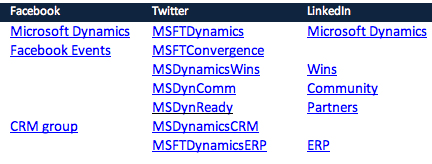
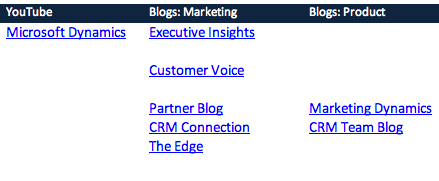
#2: Storytelling vs. Talking About Products
Rigotti's hiring coincided with a shift in marketing strategy for Microsoft as a whole. She characterizes it as a storytelling approach vs. a product-centered approach.
“We wanted to start talking to customers about what their needs are as opposed to what our products are,” she said.
Instead of talking about individual products, they would listen to their customers and then show how they could help them do their jobs better.

Discover Proven Marketing Strategies and Tips
Want to go even deeper with your marketing? Check out the Social Media Marketing Podcast! Publishing weekly since 2012, the Social Media Marketing Podcast helps you navigate the constantly changing marketing jungle, with expert interviews from marketing pros.
But don’t let the name fool you. This show is about a lot more than just social media marketing. With over 600 episodes and millions of downloads each year, this show has been a trusted source for marketers for well over a decade.
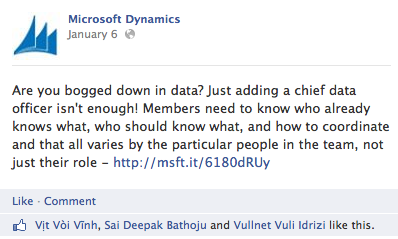
Many of the existing social accounts had been started by product specialists and had a product-centered approach. The shift meant these accounts would need to be cut, tweaked, repurposed or updated.
This required a diplomatic approach on Rigotti's part. But first she needed to track down and evaluate what they had.
#3: Selling the Idea Internally
She searched to find all of the Twitter accounts, Facebook pages and other social accounts containing “Microsoft Dynamics” and figure out who owned them.
At the same time, she and her team of two were developing the messaging and talking to the people managing the accounts.
Since they would need to give control over to Rigotti and her team, she made special effort to bring everyone on board with the idea.
“We were not saying, ‘Thanks for your two years of work, but that doesn't matter anymore,'” Rigotti explained. Instead she touted the benefits of letting her team take over the time-consuming tactical aspects of social media.
“You share your expertise with me and I'll make sure we grow the audience for that content,” was her message.
It wasn't always an easy sell. “People are really rational when they see you're not abandoning something, but instead bringing things together,” she added.
By the end of the first year, Rigotti's team had pruned their social media accounts to four platforms, focusing on Twitter, Facebook, LinkedIn and YouTube.
Rigotti said she is often in the role of traffic cop, tracking down unofficial accounts that still pop up. “It's a constant effort through education and communication,” she said. But she explains the reason for curbing additional accounts this way:
“We always ask, ‘Can we reach an audience with this account that we can't reach on our other channels?'”
#4: Content + Connections
The company has a range of audiences, including end users, purchasers and solution partners in each of five priority industries.
“We don't have specific social media communities for each one of those audiences,” said Rigotti.
So how do they reach more people with fewer social accounts? They think about what ties all these audiences together.
“We asked, ‘What's the story we can tell that will appeal to as many of these people as possible?‘” Rigotti said.
The message they developed was that the technology you use makes a difference in the way you work. That story is the common thread they use in all their content on all their social media channels.
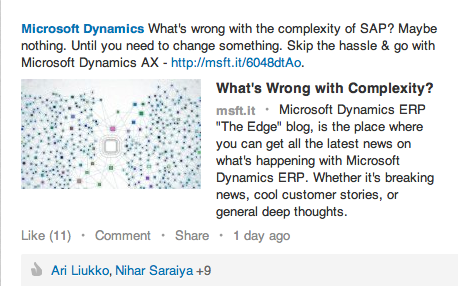
For content, Rigotti and her team rely on product and industry specialists, such as manufacturing industry experts who know what that audience cares about. Then they think about how they can socialize that information.
About 30 people contribute content as determined by an editorial calendar. “It's all about great content and great connections,” Rigotti said.
#5: Evaluating Results
The link between social media and product sales at Microsoft Dynamics is not direct, because end users typically purchase through a solution provider.
To evaluate social media activity, Rigotti said they approach it similarly to PR. The focus is on awareness and engagement.
They use the enterprise social media management program Sprinklr to track metrics such as reach, hashtag use, etc., and NetBreeze, which Microsoft Dynamics acquired in 2013, to track sentiment and mentions.
Though their measurement data is proprietary, Rigotti noted that they are getting great visibility with LinkedIn. Up to 75% of followers are seeing content from their LinkedIn showcase page. That translates to over a million followers getting their updates.
Their main Twitter account was started from scratch in 2012 and has grown to over 13,000 followers to date. Facebook and YouTube followers have grown to 10 times and 8 times their previous numbers, respectively, since mid-2012.
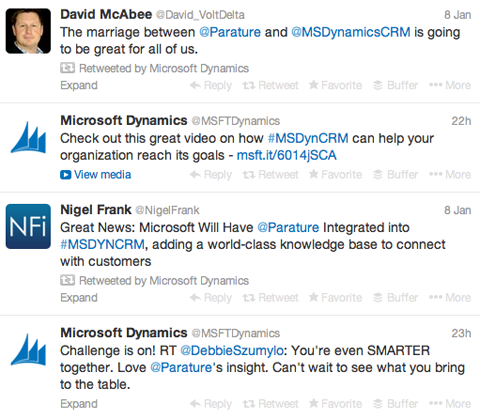
Rigotti stresses that whatever metrics you evaluate, the most important thing is to be consistent over the long-term. Looking at a snapshot of data or a small sampling of posts won't tell you much. Pick something to measure and evaluate it over time.
“Even if [the criteria] are not the most accurate, we can measure over time to see progress,” she said.
What do you think? Is your company overextended on social media? Could you benefit by pruning your accounts and focusing on storytelling to your core audience? Include your comments and questions below.
Attention Agency Owners, Brand Marketers, and Consultants

Introducing the Marketing Agency Show–our newest podcast designed to explore the struggles of agency marketers.
Join show host and agency owner, Brooke Sellas, as she interviews agency marketers and digs deep into their biggest challenges. Explore topics like navigating rough economic times, leveraging AI, service diversification, client acquisition, and much more.
Just pull up your favorite podcast app, search for Marketing Agency Show and start listening. Or click the button below for more information.

